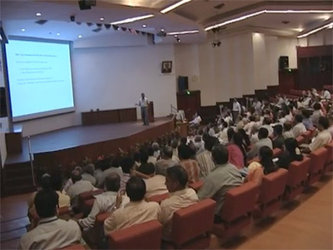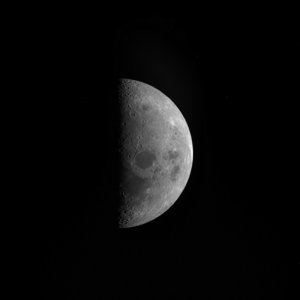Chandrayaan-1 starts observations of the Moon
The Indian Space Research Organisation’s lunar orbiter Chandrayaan-1 released a probe that impacted close to the lunar south pole on 14 November. Following this, the instruments on the spacecraft are being switched on to get the science observations started.
The Moon Impact Probe was dropped close to Shackleton crater, a place close to the south pole, where ice may exist in areas that are never illuminated by the Sun. It carried three instruments: a video imaging system, a radar altimeter and a mass spectrometer. The imaging system took pictures of the Moon as it approached the surface, the radar was used to determine the altitude, and the mass spectrometer was used to study the thin lunar atmosphere.

The probe was released from the spacecraft at 15:36 CET (20:06 Indian Standard Time), on 14 November and took 25 minutes to reach the surface. As it descended, the probe transmitted pictures to the orbiter that were later downloaded to Earth.

The Terrain Mapping Camera, TMC, and the Radiation Dose Monitor, RADOM, were functional by that time on the orbiter. After the impact of the probe, the remaining orbiter instruments were switched on consecutively for their commissioning activities.

During commissioning all standard operating modes of an instrument are exercised and the data and housekeeping parameters are examined to verify that everything is working properly.

The European near-infrared spectrometer SIR-2 was commissioned successfully on 19 November. The instrument was switched on and sent back housekeeping data indicating normal functionality. Science observations were started successfully on 20 November.
The Chandrayaan-1 X-ray Spectrometer, C1XS, was first activated on 23 November, and its commissioning is in progress.
The Sub-keV Atom Reflecting Analyser, SARA will be commissioned from 7 to 10 December. The commissioning for this instrument will take longer than usual because the instrument operates at a high-voltage, which will be increased in steps.
Notes for editors:
Chandrayaan-1, India’s first mission to venture beyond Earth orbit, was launched on 22 October 2008. The mission is led by ISRO. ESA has coordinated and supported the provision of the three European instruments on board (C1XS, SARA, SIR-2), and assisted ISRO in areas such as flight dynamics and is supporting data archiving and processing. As a result of the collaboration, ESA and ISRO will share the data from their respective instruments. Other international partners in the mission include Bulgaria and the USA.
For more information:
Detlef Koschny, ESA Chandrayaan-1 Project Scientist
Email: Detlef.Koschny @ esa.int
Christian Erd, ESA Chandrayaan-1 Project Manager
Email: Christian.Erd @ esa.int















 Germany
Germany
 Austria
Austria
 Belgium
Belgium
 Denmark
Denmark
 Spain
Spain
 Estonia
Estonia
 Finland
Finland
 France
France
 Greece
Greece
 Hungary
Hungary
 Ireland
Ireland
 Italy
Italy
 Luxembourg
Luxembourg
 Norway
Norway
 The Netherlands
The Netherlands
 Poland
Poland
 Portugal
Portugal
 Czechia
Czechia
 Romania
Romania
 United Kingdom
United Kingdom
 Slovenia
Slovenia
 Sweden
Sweden
 Switzerland
Switzerland


































